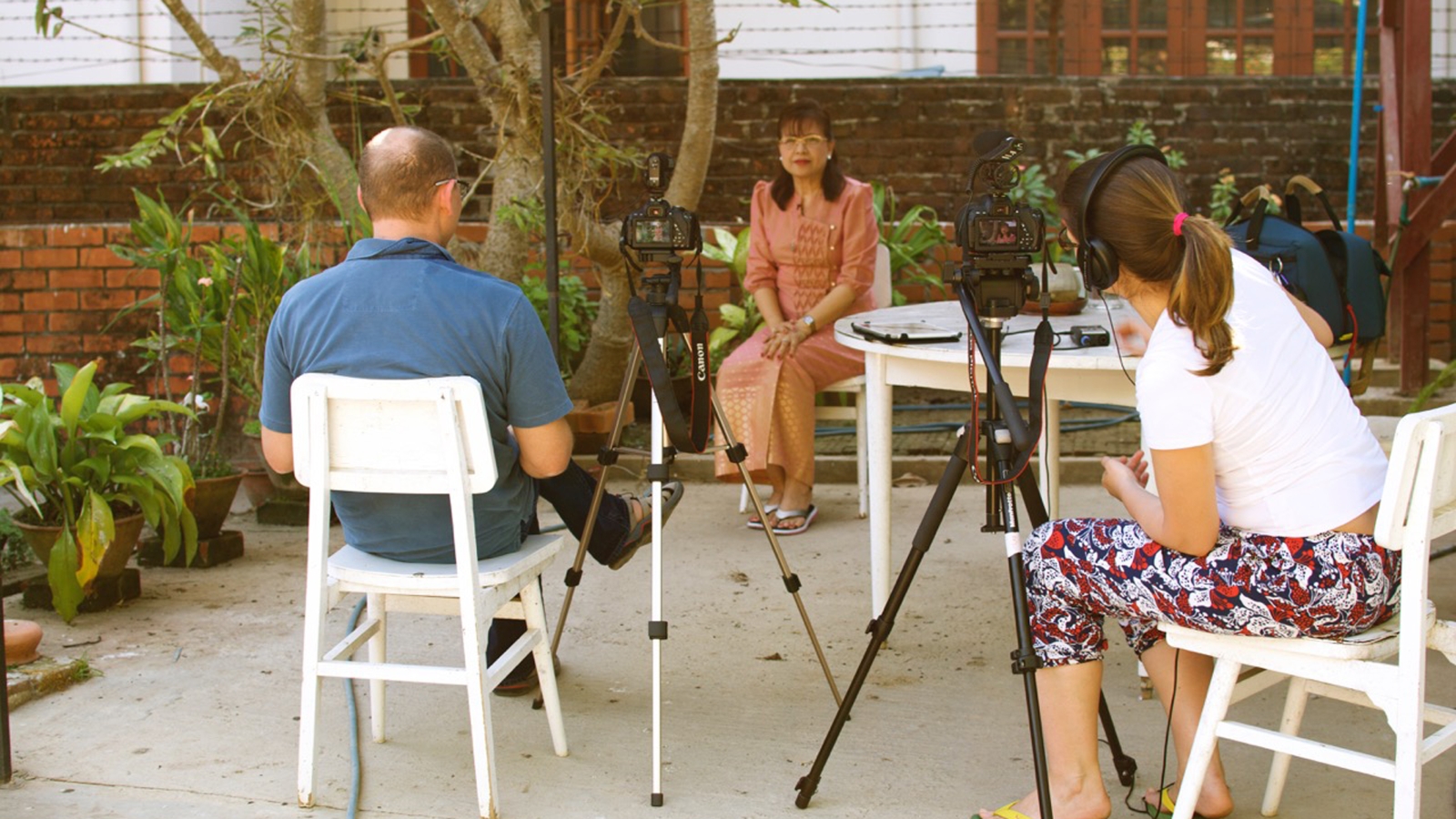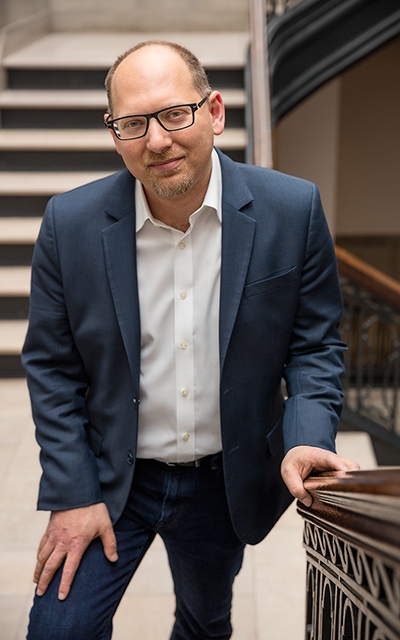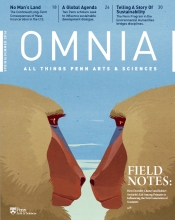A Career in Two Parts: Peter Decherney’s Journey From Film Scholar to Filmmaker

Peter Decherney recalls the moment when he truly understood the power of media. “When I was in high school, one summer I rode my bike across the country from New York to Seattle with a group of friends,” says Decherney. “We crossed the first time zone, and we all changed our watches. But when we went into a store, the clocks were still set for the East Coast time. I said, ‘You know, you’re on the other side of the line, right?’ And they told me they set their clocks according to their television reception, and they got East Coast TV shows. I realized how much the media drives so many aspects of our everyday lives.”
It was an experience that would help shape Decherney’s career-long interest in media’s past, present, and future. Today, as a professor of English and cinema and media studies, Decherney immerses himself in a range of projects, exploring territory that ranges from copyright law to software platforms to the history of cinema—and, in the process, he is crossing the line that often separates scholars from makers.
Decherney says he learned to love film at an early age after watching classics like Double Indemnity and Rebel Without a Cause on television. His latest book, Hollywood: A Very Short Introduction, reflects these roots and condenses a decade of teaching to ask the question: How can today’s technological, political, and social changes help us understand the past, and vice versa?
The book addresses everything from the progression of the studio system to the darker periods of Hollywood, such as the blacklist during the Cold War. Decherney argues that many of the elements of Hollywood we view as natural—stars, genre-driven storytelling, and blockbuster franchises—are products of cultural, political, and commercial forces. Much of the content was shaped by questions from students in Decherney’s classes. “I regularly get emails from former students who are now working in the industry,” says Decherney, recipient of multiple teaching awards during his time at Penn, and who, as part of the Penn-in-Cannes program, travels with students to France for the festival as both an instructor and go-between for introductions to major industry players. “They always tell me how important it was to study film and media history.”
Decherney hopes to reach an even wider audience of film enthusiasts with his upcoming MOOC (massive open online course) on the history of Hollywood, which will use content he has pulled together from years of teaching to provide free online lectures. Long a proponent and advocate of fair use exemptions for educational purposes, Decherney plans to utilize a wide range of film clips and interviews to illuminate Hollywood’s complex history.
“MOOCs are one of a number of exciting changes that are encouraging us to rethink the way that we teach,” says Decherney. “Like writing a textbook, they allow us to make elements of our teaching available publicly.”
Putting today’s Hollywood in context requires an understanding of the complex history of the film industry, and few issues have made as much of an impact on how movies are made than copyright law and the public domain. In the grand scheme of things, a legal battle over the hairstyle of the Munchkins in Disney’s 2013 Oz the Great and Powerful doesn’t seem very significant. But Decherney teaches that in the film industry, minor decisions make major ripples. His 2012 book, Hollywood’s Copyright Wars: From Edison to the Internet, is widely cited as a seminal study of intellectual property law in the entertainment industry, and he has lent his expertise to myriad court cases, including Golan v. Holder, a Supreme Court case dealing with the extension of copyright protections to works previously in the public domain.
“Until 1911, most films were adaptations of books, plays, biblical tales, or news stories,” says Decherney, who in 2009 was named an Academy of Motion Picture Arts and Sciences Film Scholar, awarded to scholars whose work examines the cultural, educational, historical, theoretical, or scientific aspects of theatrical motion pictures. “Filmmakers didn’t get permission to make adaptations, and no one really tried to stop them from being made.” That changed in 1909 when the Kalem Company, an American film studio founded in New York City in 1907, made a film adaptation of Ben-Hur. “This was both a best-selling book and a huge Broadway extravaganza that included horses running on treadmills. The case eventually went to the Supreme Court, where the court decided that filmmakers need permission to adapt plays and books.”
To address this issue, Supreme Court Justice Oliver Wendell Holmes, Jr., who wrote the decision, had to adapt patent law doctrine to copyright law. Patent law states that if you make something that only can be used for an illegal purpose, then the creator of the product can also be held responsible. “The example I use in my book is Steve Jobs and Steve Wozniak. Before they created the Apple computer, they sold ‘blue boxes.’ The only thing the boxes could do is trick payphones into making free calls,” says Decherney. “And so if you bought one of their boxes and used it to make a free call, Wozniak and Jobs would have been responsible even though they weren’t present when the call was made.” Similarly, after the 1911 Supreme Court case, for the first time film producers could be held responsible when theaters showed film adaptations for which the producers had not obtained permission from the copyright holders. “It may seem surprising to us, but for over a decade and a half, American filmmakers could adapt works without permission,” says Decherney. “The notion of what is and is not piracy is always shifting.”
“It may seem surprising to us, but for over a decade and a half, American filmmakers could adapt works without permission. The notion of what is amd is not piracy is always shifting.”
Evolving technology, encompassing everything from VCRs to file-sharing services like Napster, has presented a whole new set of challenges to courts, Decherney says. “It is the same question as the Ben-Hur case. Is Sony responsible if people use the VCR in illegal ways? In the end, Sony was not held responsible, because VCRs have many legitimate and socially productive uses.” More recently, peer-to-peer file-sharing services like Grokster, similar to its Napster and Kazaa predecessors, were not so lucky. “The Supreme Court decided in the Grokster case that Grokster was responsible for users’ infringing uses, because Grokster advertised itself as a tool for infringement, for piracy. And so if you’re building a business model based on illegal uses, you could be held liable.”
In addition to addressing copyright and new technology, Decherney has written about the use of the public domain in filmmaking. Navigating the maze of what is and isn’t public domain is a challenge even to film historians. All the early Walt Disney films, for example, were based on public domain stories. “When Disney decided to make his first feature-length animated film, Snow White, it was very expensive,” says Decherney. “One of the reasons he was able to take that kind of risk was that he knew Snow White was a time-tested story that was going to work. Disney built something new on the foundation of something old, something in the public domain.” But even though a story might be in the public domain, a company is able to use copyright law to protect the original elements added in their own versions. When Disney made Oz the Great and Powerful, for example, they had to digitally alter the shade of the Wicked Witch’s green skin and the hairstyle of the Munchkins because those specific aspects were protected by the copyright in the classic 1939 film The Wizard of Oz starring Judy Garland.
Surprisingly, some big franchises buck the trend, like fan favorite Sherlock Holmes, which falls under free use. Decherney, a frequent contributor to Forbes, has written multiple articles detailing the history of copyright surrounding the famous detective. “Sherlock Holmes has a long, complicated history of character protection in the U.S., because he straddles the 1923 line that separates the public domain from copyrighted works,” says Decherney. Holmes, like many classic characters, also spawns fan fiction, now almost a cottage industry for aspiring writers. As the genre becomes ever more popular—including mega-hits like Fifty Shades of Grey, which started as fan fiction of the Twilight series—the subject of re-appropriation of our favorite characters becomes more and more cloudy. Some services are embracing it. “Amazon offshoot Kindle Worlds allows you to create and upload your fan fiction,” Decherney says, “and then they’ll sell it for you and split the revenue between the fan author and the publishers.”
Though it may seem like Decherney’s vast knowledge of the film industry would provide an excellent launch pad for a film project of his own, the impetus was more a case of being in the right place at the right time: specifically, in January of 2014 in Myanmar, where he encountered a cultural moment he feared might be lost to a global population. Suddenly, the line between scholar and maker became blurred, and Decherney set about the task of making his first movie.
Decherney had traveled to Myanmar with a few filmmakers in tow, under the auspices of the U.S. State Department and the U.S. Embassy in Yangon. The mission of the visit was to explore the cultural legacy of film and how it played into modern politics in the country, so that both U.S. and Myanmar-based filmmakers and scholars could learn more about the other’s respective industries.
The larger context went back to 2011, when the dissolution of the junta led to a relaxing of censorship. This, in turn, ushered in an explosion of creativity in today’s 35th Street filmmaking district in Yangon, a collection of storefronts run by small units of filmmakers who can often be seen hand labeling their self-manufactured DVDs.
“I love to have people tell their stories, and there were all these exciting things happening in the three years after the relaxing of censorship,” says Decherney. “But there was a real sense that the 2015 election was going to be a litmus test to see if these creative liberties would be maintained. It occurred to me that this was the moment in time to tell the story of this little-known industry and its complexities, so we went back halfway across the world and started filming.” Thus Filmmaking for Democracy in Myanmar, Decherney’s first film project, was born.
For Decherney, whose only experience up to that point had been amateur photography, finding a local crew to support his efforts was crucial. He hooked up with Tin Win Hlaing, a local cinematographer. In addition to being a talented cameraman who would help capture the natural beauty of the country, Hlaing also served as a sort of guide.
“Some of our best interviews were accidents,” says Decherney. “The last day we were shooting, we went to a village about an hour outside of Yangon that functions as a kind of living set—film companies shoot there every day. A car drove up, and an actress got out, and she knew Tin. We talked with her about the industry as she put on her thanaka makeup, a tree bark-based paint the women use, and she appears in the film.”
In order to tell the inside story of an industry at odds with what many regard as a fascist regime, Decherney needed to network with a variety of local filmmakers. They included Wyne, who made the first horror film in the country to be theatrically released; Min Htin Ko Ko Gyi, a human rights filmmaker known for organizing groups of films and filmmakers in order to travel the country and show their work; and Lamin Oo, a young documentary filmmaker who studied in the U.S. and has been cited by President Barack Obama for his talent as a storyteller. Films focused on human rights have been bolstered by the newly established Human Rights Film Festival, sponsored by one of the country’s most revered figures, Aung San Suu Kyi, chairperson of the National League for Democracy (NLD).
Decherney plans to return to Myanmar for follow-up footage, especially important now that the elections have taken place (the NLD won a landslide victory, which made way for a historic meeting between Aung San Suu Kyi and the military general). The results are encouraging for the future of censorship-free filmmaking, but the future remains uncertain until the dust settles. “I’d like to see what people think afterwards. There were many projects in development that I need to follow-up on with the filmmakers. There seems to be a lot of excitement in the country, but again, it’s cautious optimism.”





